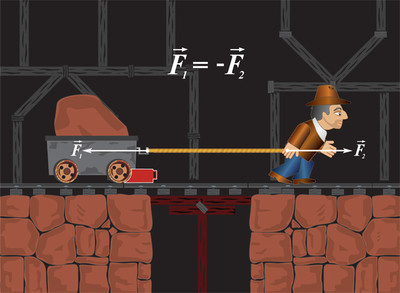SHARE WITH FRIENDS:
Newton's first law. Newton's first law is described as follows: any body maintains its state of calm or straight-line motion until the impact of other bodies forces it to change its initial state.

The fact that the soccer ball stays calm on the field until the player kicks, that we move backwards when the bus starts moving, and that we move forward when the moving bus stops, shows that this law is relevant in our daily lives.
However, Newton's first law is closely related to the concept of "inertia".
Inertia. Inertia is the property of a body to maintain a state of motion in a calm or straight line. That is why Newton's first law is also called the law of inertia. Newton's laws hold only in inertial reference frames.
Inertial reference frame. To number systems in which Newton's first law holds inertial reference frames is called. Any system that moves calmly or in a straight line relative to an inertial reference frame will be an inertial reference frame.
Experiments show that a heliocentric (coordinate heads in the center of the sun) system can be considered as an inertial reference frame. In physics, many systems are considered inertial reference frames because the errors allowed in these cases are negligibly small.
To any number system in which Newton's laws do not hold noninertial number system is called.
Now let’s get acquainted with the concepts of mass and force, which are so necessary for dynamics.
Mass. Of the body mass is one of the main characteristics of matter and is a quantitative measure of its inertia.
In other words, the mass of an object with the property of maintaining a state of calm or straight-line motion is also on the floor. In physics, the mass is denoted by the letter m. In the SI system, the unit of mass is one kilogram, i.e. [m] = 1kg. To change the state of motion of a body in a calm or straight line, it must be exposed to the outside. The concept of force is introduced to characterize such an effect.
Power. Under the influence of force, the body changes its speed of movement, that is, it acquires acceleration. This is called a dynamic manifestation of power. It can also deform a body under the influence of force, i.e. change its shape and size. This is called the static manifestation of force. The force vector is a quantity that is characterized not only by a numerical value, but also by its direction and at which point it is placed.
Force is a vector quantity that is a measure of the mechanical effect exerted on an object by other bodies and areas, and as a result of this effect the object either acquires acceleration or changes its shape and size.
Power in physics F letter designation is accepted.
How does the mechanical motion of a body change under the influence of force? Newton's second law answers this question.
Newton's second law. We conduct the experiment as follows: First, a body of constant mass (m= const) Consider the effect of different forces. For example, let a young child, a teenager, and a football player kick a soccer ball. Naturally, the ball receives the greatest acceleration when the player kicks, in other words, the acceleration the body receives is directly proportional to the force acting on it, i.e.
Now the player (F= const) Consider the case of kicking a rubber ball, a soccer ball, and a ball that boxers practice. This experiment shows that the acceleration a body receives under the influence of a constant force is inversely proportional to its mass, viz
If the above conclusions are summarized,
formed.
Or acceleration a and power F Given that vector quantities,
This formula represents Newton's second law: the acceleration the body receives is directly proportional to the force acting on it, and inversely proportional to its mass, the direction of which corresponds to the direction of the force acting on it.
Newton's third law. We talked about the effect of one body, or bodies, on another body. Naturally, the question arises as to how the affected body behaves. Experiments have shown that it also exerts a force equal to and opposite to the effect exerted. Such interactions between material points (bodies) are determined using Newton's third law: any interaction of a material point with each other has the character of an interaction. The magnitudes of the forces acting on the material points are always equal to each other, their directions are opposite, and they are directed along a straight line connecting them:
For example, suppose two boat drivers are holding on either side of a rope. We define an equal middle of the distance between them. Now let one of the boat drivers start pulling the rope. Let the other hold the end of the rope. We see that the boats meet in the middle of the equal distance between them. This experiment shows the validity of Newton's third law. The equality of centrifugal and centrifugal forces is also proof of Newton's third law.
Notification: best cvv shop
Notification: cvv fullz dumps
Notification: parts of a mushroom,
Notification: sbo
Notification: max bet
Notification: hold'em
Notification: penis envy mushroom for sale
Notification: Sbobet
Notification: best marijuana
Notification: Online
Notification: visit this website
Notification: health tests
Notification: https://www.advantageja.eu/supplements/phenq-reviews-know-ingredients-pros/
Notification: georgia pie strain
Notification: bàbbeîl kânkrathæk